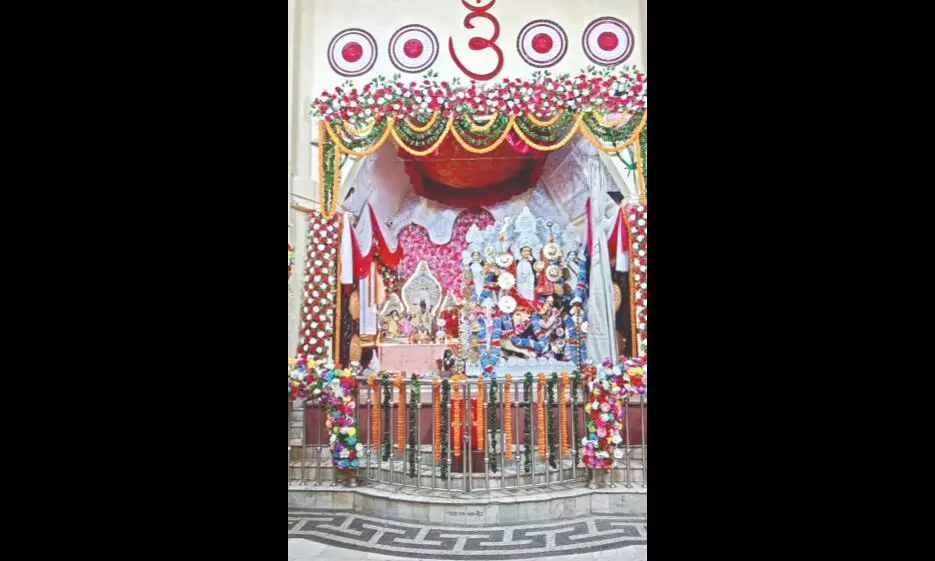Darj’s 110-yr-old Puja emerges as a home away from home

Darjeeling: Over the years the Durga Puja organised by the Nripendra Narayan Bengali Hindu Hall (NNBHH) in Darjeeling has emerged as a home away from home for the scores of service holders and businessmen who are forced to stay away from their homes in the plains. The 110-year-old Puja steeped in tradition is an oasis from many such people along with numerous tourists visiting the Hills during Durga Puja.
“Before my service in 2022, I had never missed the Durga Puja at my ancestral village in Birbhum. After joining service, I have been in Darjeeling. I miss the Puja of our ancestral village. However, the NNBHH Puja provides a touch of home and brings solace,” stated Ramgopal Mondal, Deputy Superintendent of Police, Darjeeling, while talking to Millennium Post.
For Amitabha Saha, the Puja has emerged as a saviour. “I have always been in Kolkata for Durga Puja. However, this is not always possible while in service. Initially I used to miss Kolkata Puja. Then I came across the NNBHH Puja. It has such a personal touch that it feels like a Puja organised at home where one takes part in organising and does not remain a mere spectator. I got so attached to the Puja that I am now one of the organisers,” said Saha, a doctor from Kolkata, posted at the Darjeeling Sadar Hospital.
There are many hoteliers who actively take part in this Puja. “I cannot return home for pujas as it is time for business and the hotels are usually packed. I take out time to visit the NNBHH Puja. I thoroughly enjoy the Puja with my family,” stated Biswajit Saha, a hotelier who hails from Barasat in North 24-Parganas.
From ‘pushpanjali’ to ‘bhog’ and ‘arati’, everything echoes of tradition – preserved religiously through the ages, yet preserving the hill simplicity. No pandal is erected for the Puja and the idol is placed in the main altar of the temple, popular as Shree Mandir, belonging to the NNBHH. The temple, though small in size, resembles the famous Jagannath Temple of Puri and has exotic wooden frescoes depicting mythological themes. The NNBHH has a rich history. Built during the British Raj, it is located at Chandmari. It was a two-storied stone structure and housed a spacious hall where the Hindu community used to hold meetings. The present structure came up in 1908 after a fire had razed the old structure to the ground in 1906.
In 1914, the Bengali population started the Durga Puja at the temple. Great personalities such as Sister Nivedita, Kazi Nazrul Islam, Acharya J C Bose and others paid a visit to this hall. It is said that K L Saigal, the legendary singer, had once offered Pushpanjali during Durga Puja.
During the days of the British Raj, the idol used to arrive from Krishnanagar by train to Siliguri. From Siliguri, it used to be brought to Darjeeling by the Darjeeling Himalayan Railway (popular as the Toy Train), using two engines one in the front and the other in the rear. Now the truck has replaced the train. Hurried plays and cultural programmes continued being staged after the Sandhya Arati on the Saptami, Ashtami and Nabami. Bisarjan (immersion) is also unique.
The idol is carried on the shoulder and taken all over town and then by truck to a spring called Bangla Khola near Sonada where the immersion takes place.
“We have tried to preserve the essence of the Puja as it was done 100 years ago. However, the biggest problem we face these days is the steadily diminishing Bengali population. Most of the old Bengali families of Darjeeling, specially the youths have migrated owing to lack of job opportunities in the Hills. Even organising the Puja is becoming difficult, let alone cultural programmes,” stated Subasish Sengupta, one of the organisers.



